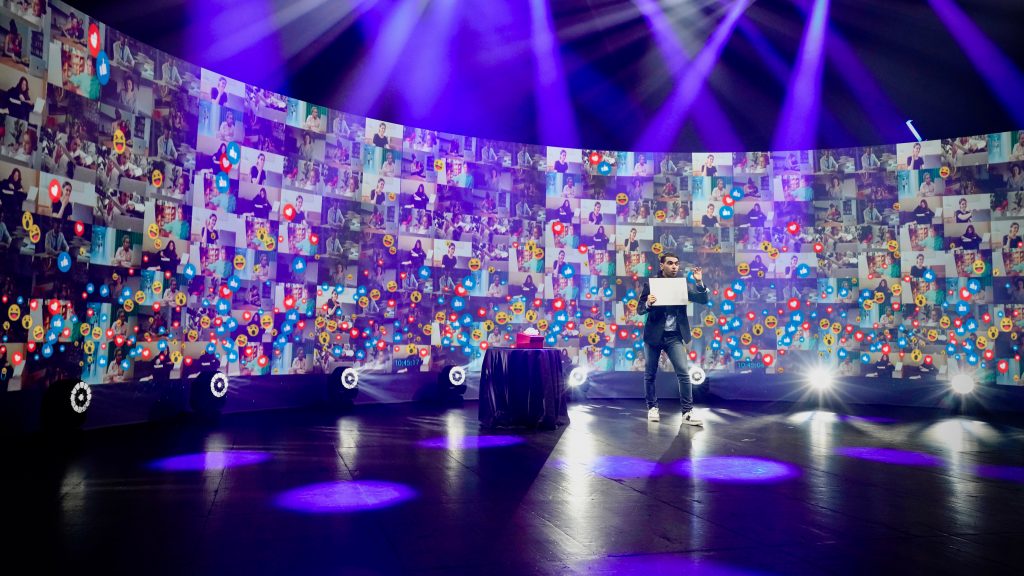Zoom, Teams, Google meet… Digital is omnipresent. Are you too saturated with videoconferences? 😰 It is true that these tools have been really useful to us in recent months, to say the least. Now, isn't it time to rethink virtual events?

What if, digital dating was not invariably synonymous with impersonality. The solution to the “physical or digital” question turns out to be much more ambivalent than we imagine. The team We Are COM deciphers neo-events for you. Vincent Bruneau, founder & CEO of Sparkup, platform specializing in the engagement of participants in meetings and events, face-to-face and virtual, enlightens us. 💡 Spotlight on the event phygital !
???? Hello Vincent, as CEO of Sparkup, could you give us your definition of engagement?
Strictly speaking, engagement is not a definable concept. It depends on many factors and requires real cognitive and emotional questions, so that its action has an effect over time.
On the one hand, the organizer behind the event must establish its strategy commitment. Above all, he must be aware of the style of experience he wants to develop. It is imperative for him to question himself about the emotion he wishes to arouse during the event in question. Finally, it is necessary that the interest aroused materializes in the long term, in other words that the commitment is memorial and generates benefits.
On the other hand, this tripartite reflection applies to the participants. Are they involved at time T? What emotions can arise from this? And finally, will a reaction be generated a posteriori?
There are, in my opinion, four categories of spectators:
- > The passive spectator, who can drop out and withdraw from the event at any time
- > The spectator involved, which, as the name suggests, will show involvement. He gives his opinion, reacts, votes, asks questions ...
- > The spectator actor, which creates added value contents
- > The spectator actor "balance sheet", who builds on the experience and puts their learning into practice
Our name was not chosen at random. Indeed, "spark" means "spark", and it is precisely this spark that we want to bring to events, in order to optimize engagement rates.
It was essential to offer an experience centered on people and interactivity
🤖 You recently launched the “Sparkup Now! To meet the growing demand for “hybrid” events. Can you tell us more about the bottom of this immersive experience?
Over the past few months, we've all seen endless online meetings, boring webinars, and top-down virtual events that lead to fatigue and dropping out. With Diffusis, we carried out a study on a thousand people in order to know the different feelings towards meetings and virtual events. The numbers speak for themselves: 55% of respondents believe that they do not feel listened to and 75% say that they are not, or have very little difficulty, involved during these virtual meetings.
It is therefore quite natural that we imagined the “Sparkup Now! ". It was essential to offer an experience centered on people andinteractivity, which can respond to moving issues. With “Sparkup Now! " our ambition is to fight inattention and maintain engagement. We allow all remote participants to experience the event as if they were in the front row. Our solution uses the screens of the studio or the stage to broadcast a video mosaic of each of the participants and make them all visible, as if they were present. It is a unique way of valuing them and reinforcing the feeling of belonging to the event.
Otherwise 65% to 70% of our language is non-verbal, which is why it is essential to make participants visible from a distance. Emotion is contagious, so the visual channel is fundamental to virtual events. It is essential that the spectators feel they are really part of the event. This is why “Sparkup Now! » also provides a layer of interactivity, allowing the public insurance to share their emotions in real time: vote, ask questions and participate in fun quizzes. Did you know that gamification generates dopamine as well as endorphin, the hormones of happiness?
To achieve maximum public attention, It is also important to set a “zero latency” goal. Immediacy is a major condition for interactivity. It is indeed not possible to wait even a few seconds for the result of a vote, or even a wave of applause. For this, we have created and perfected our own system of diffusion, with ultra-low latency.
Finally, and this is why I like to think that our offer is unique, we have worked on an artificial intelligence capable of accounting for the commitment of the participants. What were the emotional peaks? How did the engagement rate change during the event? This anonymous feedback allows our users to better understand their participants and the impact of their content.
Emotion is contagious, so the visual channel is fundamental to virtual events.
👊 What were the challenges you had to overcome in the development of this interactive digital device?
I would say that we had to face three main challenges. First of all, there is a difficulty at the customer level. Recently, we signed a contract with a company that wanted to organize a meeting with 50 participants. With word of mouth, third parties also wished to participate in the experiment, rapidly increasing the number to 000. It is essential that the issue of connection to the stream must be resolved before D-day.
The second issue was the desire to make our mosaic intelligent. It is important that participants who do not wish to activate their webcam do not become black thumbnails on the screen. To do this, connections are automatically updated very regularly to make room for visible participants.
we had to face new challenges in terms of achievement. We have collaborated with real directors to acquire a new dynamic, to discover a new way of producing, of filming. It is always interesting to observe with what mastery technology knows how to adapt to human know-how.
👀 Do you have a concrete example of the implementation of your solution?
Most often “Sparkup Now! »Has been used at conventions, events customers, events internal… Meetings which brought together on average several hundred face-to-face participants, and which, with the virtual, have been able to increase the number of participants up to several thousand in some cases.
A concrete example of the use of “Sparkup Now! Was an internal event organized by one of our clients in the cosmetics sector. This event, which usually brought together around a hundred face-to-face employees, turned into a virtual meeting bringing together the 1900 employees of the company, spread all over the world. The challenge was to maintain a feeling of cohesion, spontaneity and interactivity. Thanks to “Sparkup Now! », The CEO was able to see and talk to all of his employees. The participants were also able to interact, everything being extremely fluid thanks to our streaming ultra-low latency. In total, we collected over 450 live reactions over a 000 hour event. A record of commitment and sharing of emotions!
We are also seeing a growing demand for smaller events of 50 to 100 people. “Sparkup Now! »Has the advantage of being able to adapt to all formats. Customers can cast a mosaic on any screen.
🤔 We know that digital technology can sometimes have unpleasant surprises in store for us, especially live. How can the risk of unforeseen events be reduced as much as possible? Do you have any best-practices to share with us?
Technical problems are rarer than they appear in digital events. As with any event, you have to repeat and repeat always. The risk cannot be totally eradicated, however it can be greatly reduced with practice and expertise. Each scenario must be considered in order to be able to prevent it. Training the speaker in the different hazards can be very useful. We like to count 3 to 4 weeks of preparation before the grand finale.
As for the technical issues on the participant side, that's another matter. The most widespread risk remains the bad internet connection of one or more spectators. The only solution is to warn them a priori by sending them specific recommendations. IThere aren't really any good practices. You have to keep it simple above all. Our platform has been designed to be extremely intuitive: all you have to do is click on a link from a simple browser on your mobile or computer to participate in the event. No installation required, no account to create.
🇧🇷 In your opinion, have events and digital become inseparable? How to humanize the virtual relationship?
I would say yes. We will see an increase in the hybrid format for medium-sized events, some of which cannot attend. As for important or annual events, they will require the development ofExperiences always more interactive and more unique.
The human will never be very far from all this, the digital tends to take again the codes of the emotional intelligence. It is capital, and especially in the era of PRESENCE, to give spectators the feeling of being real actors, present, listened to and heard. “Sparkup Now! »Has the will to erase the distance, so that each participant feels closer to his peers.
Humanizing the virtual event is a huge challenge. To take it up, we called on semiologists and sociologists. We work in particular in close collaboration with the semiologist Élodie Mielczareck to rethink languages, verbal and non-verbal. It is essential to reflect in depth on what is codifiable and what is not. Personally, I always find it impressive to attend a work of collective intelligence, where the different actors enrich each other.
The human will never be very far from all this, the digital tends to take again the codes of the emotional intelligence.
(I.e. What do you think are the other major developments in digital events? What will be the challenges ahead?
The fundamental change in the sector will lie in the implementation of micro-event strategies. In other words, it will be essential to bring together and federate communities in the medium and long term. The platforms have understood this: it is no longer possible to limit yourself to one or two big events per year. The cohesion and commitment of hearings can only be done through the regular organization of micro-events and the rhythmic distribution of attractive content. The flow of information must become continuous!
The participant should not feel the obligation to be accountable, his presence should be a result of his own will. Arousing a strong interest in order to encourage participation is the sine qua non for innate and light commitment. Always remember that engagement is invisible!
The other major evolution of events lies in the development of content. Previously, the world of communication and that ofaudio-visual rubbed shoulders, now more than ever they need to collaborate.
The fundamental change in the sector will lie in the implementation of micro-event strategies.
✅ Thank you for this exchange Vincent. Finally, do you have any advice for communicators?
The best advice I can give is to follow a simple process. An event is one-off. It is the result of setting up a specific scenario, within a given period of time. Top-down content is the communicator's enemy. The real issue is to engage on targeted and relevant content. You have to know how to show always more human and always more creativity to energize the speeches and generate the desired interaction.
3 things to know about Vincent Bruneau
- > His favorite media? Very interested in the world of startups and French tech, Vincent appreciates Clubhouse and Madyness.
- > Her favorite ad? La countryside " Did you mean Mailchimp? By Mailchimp who played on the fact that people basically couldn't write their name correctly. Mailchimp has been declined in MailShrimp, JailBlimp, Nailchamp, etc. This funny strategy targeted different sectors such as music, cosmetics, food… An original campaign, with a simple message, was awarded a Lion d'Or in Cannes.
- > Her passion ? Vincent was a magician and mentalist before founding Sparkup.







